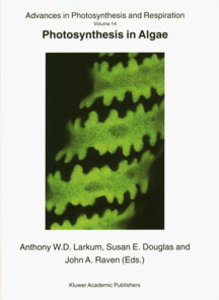Photosynthesis in symbiotic algae
Yellowlees, David, and Warner, Mark (2003) Photosynthesis in symbiotic algae. In: Larkum, Anthony W.D., Douglas, Susan E., and Raven, John A., (eds.) Photosynthesis in Algae. Advances in Photosynthesis and Respiration, 14 . Kluwer Academic Publishers, Dordrecht, The Netherlands, pp. 437-455.
|
PDF (Published Version)
- Published Version
Restricted to Repository staff only |
||
![[img]](https://researchonline.jcu.edu.au/7440/2.hassmallThumbnailVersion/7440_Yellowlees_2003_Book_Cover.jpg)
|
Image (JPEG) (Book Cover)
- Cover Image
Download (39kB) |
Abstract
[Extract] Symbiosls is an evolutionary strategy that often confers an ecological advantage on the partners. Algae exist in symbiosis with a number of hosts and in a range of different anatomical relationships including exosymbiosis (lichens) and endosymbiosis (corals). Each of these imposes on the alga a chemical environment significantly different from that of free-living algae and this impacts on algal photosynthesis. This chapter examines how symbiosis influences the acquisition of inorganic carbon by the alga, its subsequent photosynthetic fixation and translocation back to the host. Inorganic carbon acquisition in symbiotic associations is invariably more complex than in free-living algae as it often is acquired through the host tissue which is different in nutrient composition and concentration, as well as pH, from the surrounding aquatic environment. In many instances the algae posses carbon-concentrating mechanisms to ensure the CO2 concentration is adequate for productive carbon fixation by Rubisco. For the majority of algal symbionts photosynthetic carbon fixation is the major contribution algae bring to symbiosis. The translocated photosynthate provides much of the carbohydrate required for respiratory energy generation in the host. Evidence suggests that the host influences carbon fixation in the symbiotic algae to that effect. In symbioses between dinoflagellates and invertebrates, the secretion of photosynthate form the symbiotic algae to the host is believed to be under the control of a 'host factor'. However, the chemical nature of this factor has not yet been established. This chapter also examines the possible link between thermal/light stresses on the algal photosynthetic apparatus in the dinoflagellate-coral symbioses. There is compelling evidence that this initiates coral bleaching; the breakdown of the symbiotic association resulting in the expulsion of the algae from the symbiosis. The mechanism by which thermal/light stress triggers this process is thought to occur is either through the inactivation of a key component in the carbon fixation process (e.g. Rubisco or the carbon-concentrating mechanism, or by damage to the Photosystem II reaction center, probably the D1 protein.
| Item ID: | 7440 |
|---|---|
| Item Type: | Book Chapter (Research - B1) |
| ISBN: | 978-0-7923-6333-0 |
| Keywords: | algae; carbon fixation; inorganic carbon; symbiosis |
| Date Deposited: | 11 Jan 2010 03:01 |
| FoR Codes: | 06 BIOLOGICAL SCIENCES > 0607 Plant Biology > 060705 Plant Physiology @ 100% |
| SEO Codes: | 97 EXPANDING KNOWLEDGE > 970106 Expanding Knowledge in the Biological Sciences @ 100% |
| Downloads: |
Total: 127 Last 12 Months: 2 |
| More Statistics |



